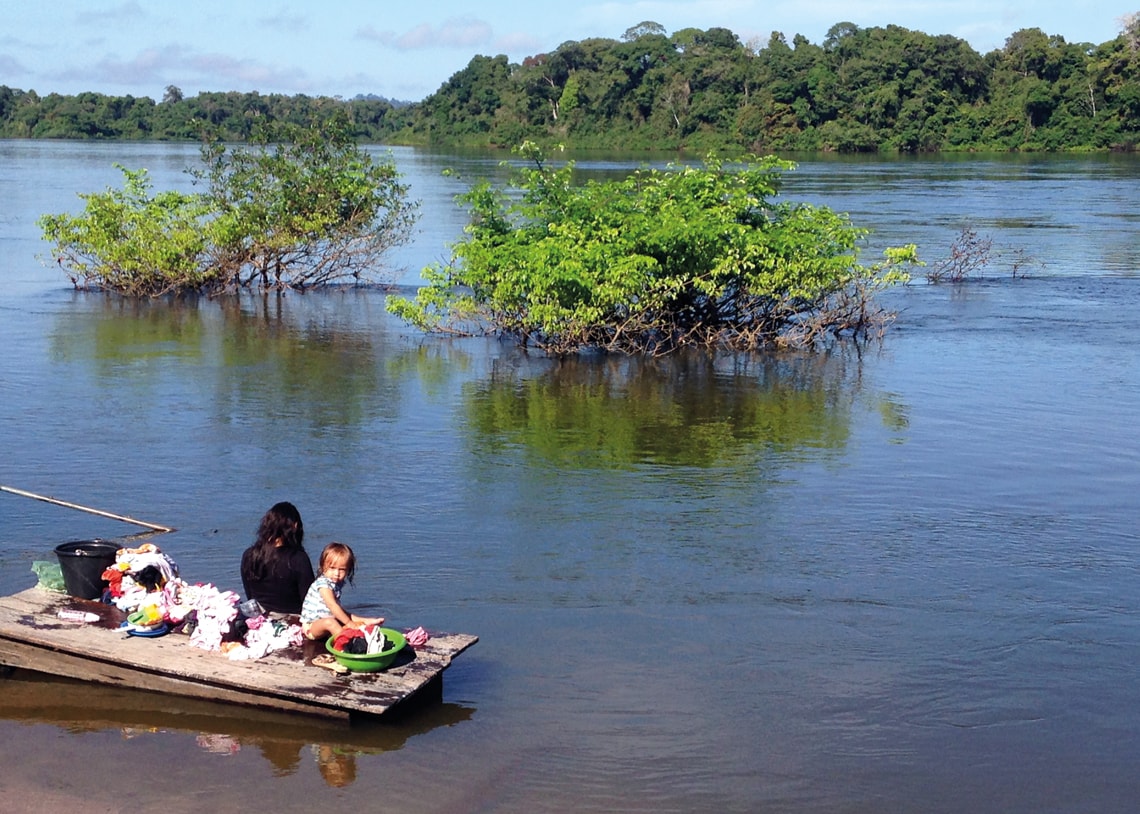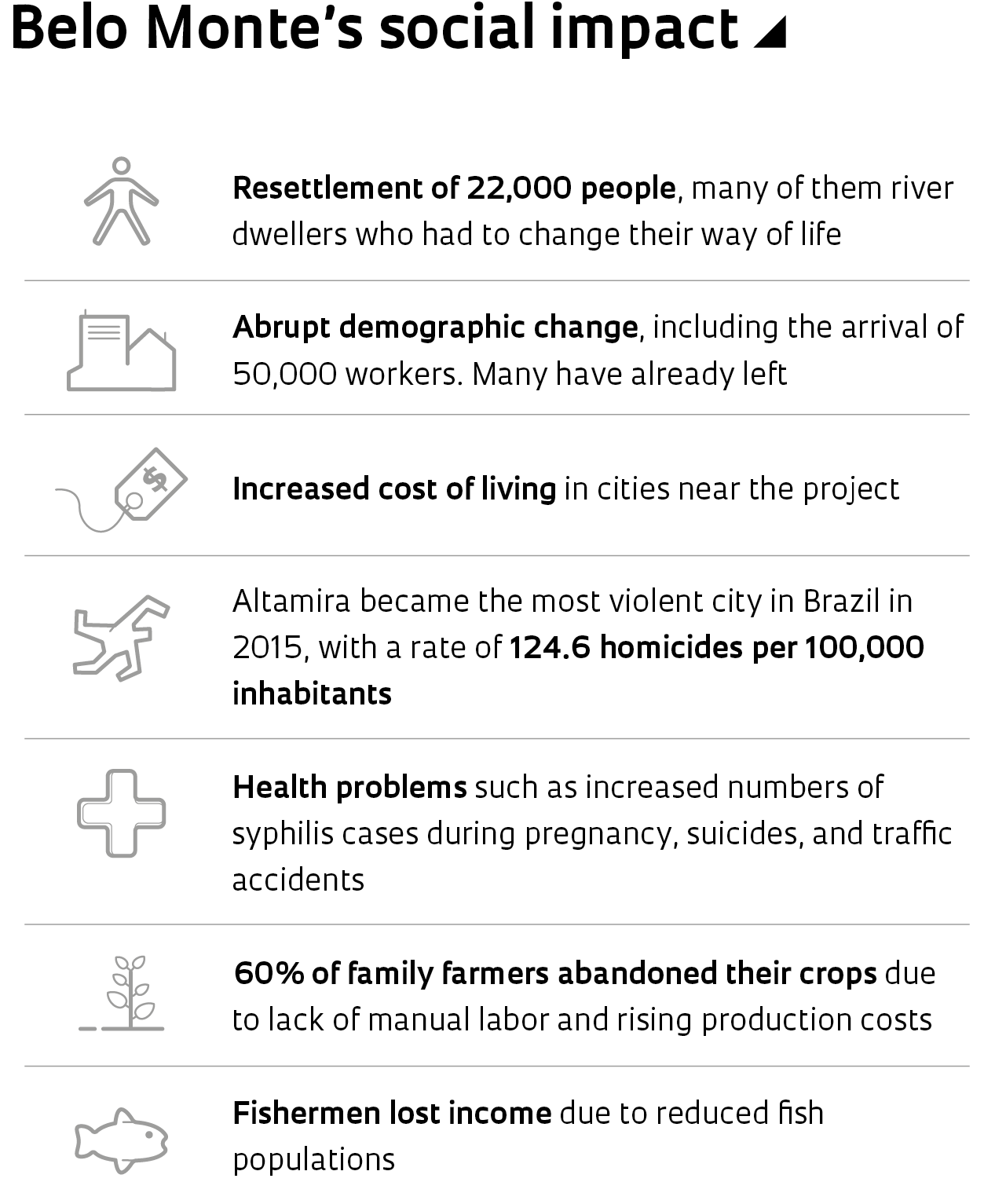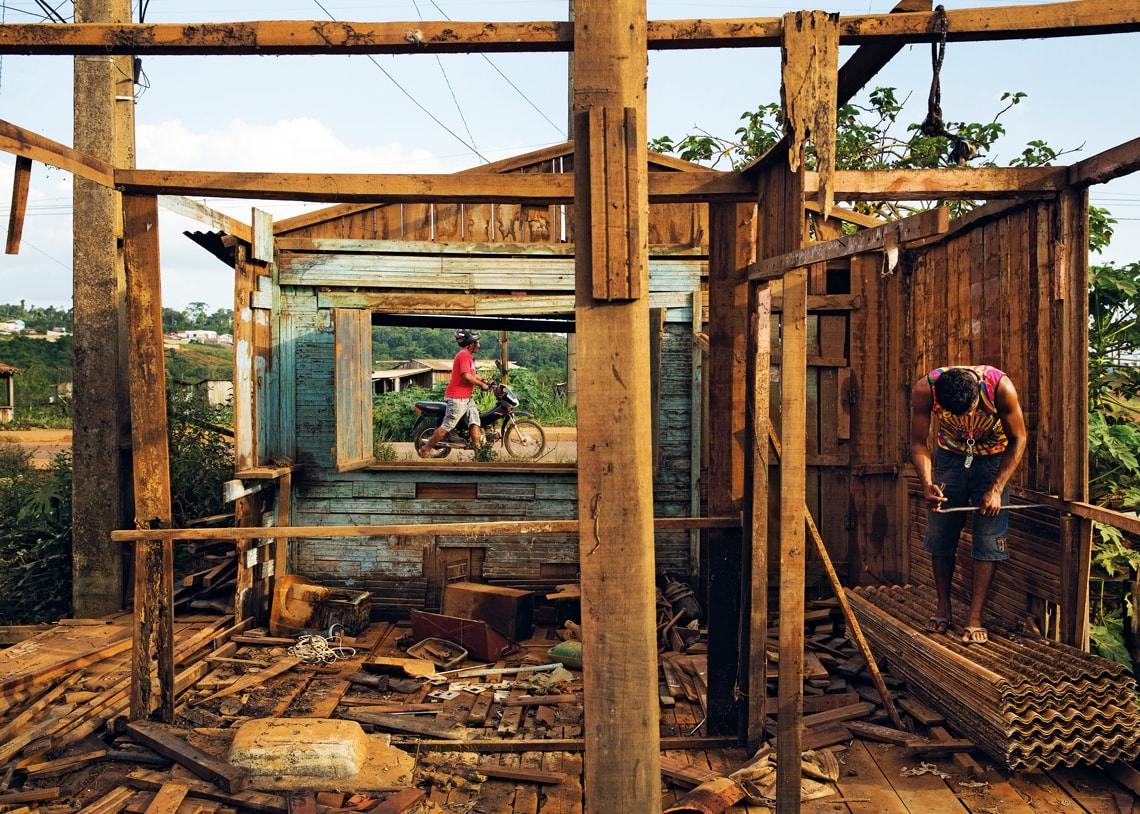The Amazon Basin occupies 3.8 million square kilometers across seven Brazilian states and accounts for more than 60% of the country’s available water. It is considered the region with the greatest potential for expanding hydroelectric generation in the National Energy Plan (PNE) developed by the Energy Research Company (EPE), which is associated with the Brazilian Ministry of Mines and Energy. However, recent studies regarding the socioenvironmental impacts of building hydroelectric dams in the region, and the ability of these power plants to generate the intended results over their useful life, suggest caution.
“Amazonian hydroelectric dams are only economically competitive with other energy sources if their social, environmental, and eventual removal costs are not included, if the calculation is based on the cost of the installed energy rather than the energy actually produced, and if the costs of fair compensation—which are passed on to society—are not taken into consideration,” says Emilio Moran, a professor of anthropology, geography, and environmental sciences at Michigan State University (MSU) in the United States, and at the University of Campinas (UNICAMP). Moran coordinated a multidisciplinary team of professors and researchers from the areas of health, geography, anthropology, and agricultural and environmental economics at UNICAMP, MSU, and the Federal Universities of Pará (UFPA), Rio Grande do Sul (UFRGS) and Santa Catarina (UFSC), as well as the University of St. Gallen in Switzerland. They went into the field in southwestern Pará to assess the social and environmental impacts generated by the construction of the Belo Monte hydroelectric power project on the Xingu River. The results were announced at the end of August, at an event held in São Paulo.
The research found that the hydroelectric project caused damage to local fish biodiversity and the human populations of Altamira and Vitória do Xingu, cities close to the project. Some of the damages observed include the rising cost of living, declining income of family farmers and river dwellers, decreased fishing, deteriorating health indicators, poor sanitation, and an increase in violence. “What happened at Belo Monte was predictable, as it had already happened before with other hydroelectric projects. It only demonstrates that the state continues to make the same mistakes it made 40 years ago,” says Moran, referring to the socioenvironmental impacts recorded in the 1970s and 1980s during the construction of the Tucuruí hydroelectric project on the Tocantins river, and the Balbina hydroelectric plant on the Uatumã river, a tributary of the Amazon, projects whose impacts were not duly considered in the construction of Belo Monte.

Maíra Fainguelernt
Daily life on the river: butane cooking fuel is transported by boatMaíra FainguelerntThe National Energy Plan was launched in 2006 and received its most recent update in 2018. It contains energy consumption forecasts and maps out the opportunities for expanding the energy supply through 2050. According to the document, the demand for energy is expected to rise at a rate of 1.4% to 2.2% per year over this period, depending on the country’s economic growth. Brazil’s hydroelectric potential was estimated at 176,000 megawatts (MW). Of these, 108,000 MW are already available or being provided by other projects. Of the remaining 68,000 MW inventoried, 52,000 MW correspond to projects involving the construction of medium and large hydroelectric plants. Of this total, 64%, or 33,000 MW, is foreseen coming from the Amazon Basin.
American biologist Philip Martin Fearnside, one of the winners of the 2007 Nobel Peace Prize (as a panel member of the Intergovernmental Committee on Climate Change), is an expert on the Amazonian region, where he has been working as a researcher at the National Institute for Amazonian Research (INPA) since 1978, and was a guest at the recent event. He pointed out that the hydropower potential of the Amazon Basin has been exaggerated and that the investments will not bring the expected results. “They are not considering, for example, the effects of global warming, which reduces rainfall and consequently the flow of water in the rivers,” he claims.
Fearnside cites a study by the federal government’s Department of Strategic Affairs (SAE) in 2015 titled “Brazil 2040,” which projected the consequences of global warming for the country’s climate. For the Amazon region, the projection indicates a substantial decrease in rainfall, which will be reflected in the volume of river water and hydroelectric generation capacity. Impacts will likely be different for each river basin. In the projected scenarios, the generation capacity at Belo Monte, for example, could be reduced by 20% to 55%.
Hydroelectricity is regarded by the industry and some experts as a clean form of energy because it doesn’t burn fossil fuels. Fearnside considers this perception to be mistaken, especially regarding hydroelectric dams installed in forest regions. “There are substantial quantities of greenhouse gas emissions,” he states. Studies conducted by the scientist indicate that the first years of activity of a hydroelectric dam are responsible for large emissions of carbon dioxide (CO2), methane (CH4), and nitrous oxide (N2O). According to his research, the time it takes for a dam to generate benefits by reducing greenhouse gas emissions is measured over decades and varies according to the location, size, and profile of the area occupied by the dam. In Belo Monte, with the first dam planned upstream, the researcher estimates it could take 40 years.

Maíra Fainguelernt
Mother and daughter wash clothes in the riverMaíra FainguelerntDepending on the Xingu river
The Belo Monte hydroelectric complex is made up of two powerhouses, that is, two power plants, with a total of 24 turbines and a total installed capacity of 11,200 MW, which should be achieved by the last quarter of this year when the last four turbines go into operation. As a result, Belo Monte will become the third-largest hydroelectric facility in the world in installed capacity. But not in actual production. In Belo Monte, the supply of firm power, or guaranteed production capacity, is limited to 4,400 MW on average. Actual production depends on the flow of the Xingu River. During the region’s dry months, between June and October, its generation capacity is greatly reduced.
Belo Monte is a “run-of-river” power plant, that is, its reservoir was designed to allow a regular flow of water for a few days of operation and not for the entire dry season. Therefore, its reservoir is almost three times smaller than necessary for a traditional power plant. Even so, it adds up to 478 km², with its two reservoirs, which are interconnected by a 20-kilometer diversion channel.
In January 2011, when construction at Belo Monte began, the hydroelectric plant was budgeted at R$16 billion. Last July, the Ministry of Mines and Energy estimated its total cost at R$42 billion. The plant belongs to Norte Energia S.A., which counts state-owned Eletrobras as its main shareholder, with 49.98% of the shares. The investment—around 80%—was financed by the Brazilian Development Bank (BNDES).

Miquéia Calvi, a professor at the UFPA School of Forest Engineering, has lived in Altamira for 30 years. He closely observed the communications promoted by the federal government and the Norte Energia group to persuade the local population. He says they established a compelling narrative of how the dam would be conducive to regional development, generating employment and income for farmers and local traders, and improvements in providing public health, sanitation, water distribution, security, and housing. “They gained a lot of support for the project, which today is almost nonexistent,” he says.
Emilio Moran sums up the current perception of the local population in one sentence, repeated over and over to researchers involved with the project, in regard to the social and environmental impacts of Belo Monte: “Good for Brazil, terrible for us.” Their study’s results illuminate the reasons for the change in public opinion. Before Belo Monte, Altamira was a city of 75,000 residents. Two years after the start of the project, there were almost 150,000. The construction of the plant generated 50,000 direct and indirect jobs, a contingent that decreased as the various stages of work were completed. In 2018 the estimated population was 113,000 inhabitants.
This demographic movement has had consequences, including for the health of the population. Márcia Grisotti, Head of the Department of Sociology and Political Science at UFSC, studies the impacts of Belo Monte. She highlights the increase in syphilis cases in pregnant women in the city of Altamira, which went from one case for every thousand children born in 2010, to 15 cases in 2015. Violence has also increased. In 2015, Altamira won the undesirable title of the most violent city in Brazil. According to data from the Brazilian Ministry of Health, there were 124.6 homicides per 100,000 inhabitants. Five years earlier, the rate was 60.9 homicides per 100,000 inhabitants. There was also an increase in suicides and deaths from traffic accidents. “Compensatory measures related to health issues were restricted to the installation of medical and sanitary equipment, without monitoring health indicators or defining a strategy to mitigate problems that could have been prevented,” Grisotti says.
Belo Monte will be the world’s third-largest hydroelectric facility in installed capacity but not in actual production
The construction of the Belo Monte dam and raising the Xingu river’s water level required the displacement of 22,000 people living along the riverbank. This population was relocated to five Collective Urban Resettlements (RUCs) on the outskirts of Altamira. But not without problems, notes Guillaume Leturcq, who teaches the UFRGS regional development course. “People who had made their livelihood from the Xingu were settled in villages three or four kilometers from the river,” he says. “They weren’t offered the opportunity to relocate to places where they could maintain their livelihood.” Many of the new homes have already been abandoned or sold.
The increased population density has created sanitation problems. Until 2012, 86% of the area’s water supply came from wells, and 90% of the houses used septic tanks for sewage. According to Cristina Gauthier of MSU, Norte Energia did improve Altamira’s sanitation infrastructure, but not enough for the population growth the city confronted. As a result, the use of wells and septic tanks remains common throughout the area. “With the increased population density, the number of wells and septic tanks is actually higher than before the hydroelectric project’s construction. More septic tanks impacts the region’s groundwater quality,” says Gauthier. In a survey conducted in 30 houses, the researcher found that only six wells had water without fecal contamination during the dry season, and only seven in the rainy season. Norte Energia did not comment on the results of the research when asked.
Even riverbank residents living in areas farther from the power plant, who were not required to leave their homes, were affected. Residents of the downstream community of Vila Nova, which has 156 families, report that today they have to fish for six days to catch the same number of fish they once got in two. Moreover, the fish are smaller, and more difficult to sell. “In Altamira it’s possible to buy fish from other regions of Pará and Santa Catarina. Only one supermarket sold local fish in 2015,” says Micah Calvi.

Lalo de Almeida / Folhapress
Relocated from his home because of the hydroelectric dam, a resident tears down his stilt house near the Altamira channelLalo de Almeida / FolhapressCalvi investigated the impacts of Belo Monte on agricultural production in the Altamira region. “The promise was that the increase in population and demand for food would benefit the local producer,” he notes. However, three years after the start of the project, 60% of family farmers had abandoned their seasonal crops. Cultivation of rice, beans, corn, and cassava fell from 40,000 hectares in 2011 to 20,000 hectares in 2017.
Emilio Moran believes that many of the problems observed in their study could have been avoided if approval of the hydro project had been preceded by an adequate Environmental Impact Study and the consequent Environmental Impact Report (EIA-RIMA). For this to occur—and as Brazilian law mandates—it would be necessary to study the region in advance, in both its physical and human aspects, and listen to the local communities. Public agencies such as the Brazilian Institute of the Environment (IBAMA), in Moran’s estimation, should also have “the capacity and political will” to deny licenses, if it is found that a particular undertaking does not meet the obligations of Brazilian law or the recommendations of the social and environmental impact report. “This never happens in Brazil,” he laments. “The studies are done, but the construction begins without solving the problems pointed out in the studies.”
Physicist José Goldemberg of the Institute of Energy and Environment of the University of São Paulo (IEA-USP) and former National Secretary of the Environment, Science, and Technology, only partially agrees with the criticism. In his view, many of Belo Monte’s social and environmental impacts could, in fact, have been avoided, and the company should be held responsible for the damages it has caused. However, Belo Monte, he believes, shouldn’t be judged for social damages only, but also for the benefits generated for the entire nation’s energy supply.
In his opinion, hydroelectric dams in the Amazon Basin should be assessed on a case-by-case basis, taking into account their feasibility in view of the costs of mitigating social and environmental impacts and the possible effects of climate change, but should not be ruled out categorically. “Brazil needs to expand its production of electricity, and a hydroelectric system, among the options that guarantee firm power generation, is a better alternative than power plants that burn fossil fuels, or nuclear energy facilities,” he says.
Brazil has the second-largest hydroelectric power generation system in the world—second only to China—with an installed capacity of 94.7 thousand megawatts (MW), which meets 60% of the country’s needs, according to 2018 data from the Energy Research Company (EPE). The country was one of the pioneers in investing in the power of water to generate electricity.
The first national hydroelectric dams date from the late 1880s, in Minas Gerais. In São Paulo, the Henry Borden hydropower project, inaugurated in 1926, was instrumental in supplying energy for the state’s industrialization. Brazilian engineering gained expertise with the construction of these projects, and in the 1980s erected the Itaipu hydroelectric dam, which was the largest in the world until it was surpassed by the Three Gorges dam in China, in 2003.
Today, given hydropower’s financial, environmental, and social costs, Emilio Moran argues the country needs to prioritize energy sources such as wind and solar. “Hydroelectric expansion is no longer sustainable,” he states. “But the country has the potential, yet untapped, for harnessing the sun and wind.” Moran also warns of the risks the country faces by not preparing to absorb the impacts of climate change. The reduction in available water to supply hydroelectric plants has forced hydro managers around the world to modify their power production infrastructures. “One solution is to lower the turbines, adapting them to lower water flows,” he says. This is what was done at the Hoover Dam on the Colorado River in the United States. Another solution is to provide the reservoirs with floating photovoltaic plates, which take full advantage of the already existing power distribution structure. This is being tested at the Sobradinho Dam, on the São Francisco river, and on a larger scale in China.
Project
Social and environmental processes that accompany the construction of the Belo Monte Dam, in Altamira, Para (nº 12/51465-0); Grant Mechanism São Paulo Excellence Chair Program (SPEC); Principal Investigator Emilio Federico Moran (UNICAMP); Investment R$1,268,685.34.
The 22 articles produced within the ambit of the research are available online
Republish

